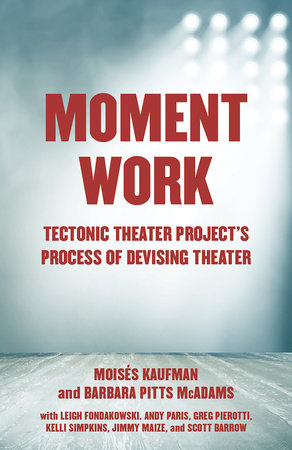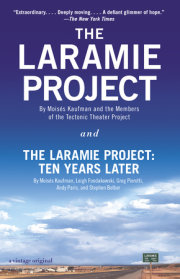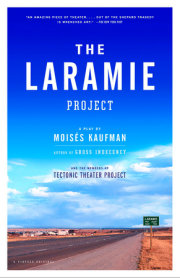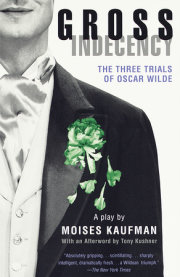INTRODUCTION
by Moisés Kaufman
The stage is the arena that most awakens my sense of wonder. I’m fascinated by what’s possible on stage, and by the myriad ways we can create theatrical narratives that generate riveting and profoundly intimate dialogues with an audience. It is this sense of awe and curiosity that led me to found the laboratory that is now Tectonic Theater Project.
Growing up in Venezuela, I had the good fortune of seeing the work of artists such as Peter Brook, Pina Bausch, Jerzy Grotowski, and Tadeusz Kantor at Caracas’s world-class international theater festival. These artists were rigorously exploring the potential of the stage. They created strange and wonderful new worlds that could exist only on the stage. Every aspect of these productions—sets, acting, sound, movement—helped build a new reality. Their work was experimental, adventurous, and very theatrical.
I was so used to these experimental works that when I saw my first “realistic” play, I thought, “This is so avant-garde! Look, there’s a sofa onstage! And water comes out of that faucet!” I guess my reaction must have been similar to that of the audience in Moscow in 1896, when
The Seagull premiered. For them (as for me), naturalism was a new form that broke with all prevailing theatrical conventions. And because of the newness of that form (Masha sitting with her back to the audience, sounds of birds and horse carriages in the distance!), the audience was invited (or
forced) to experience the content of the piece in a different way. Chekhov’s words were given a new canvas on which they could communicate with that audience.
This early exposure to a broad range of theatrical vocabularies ignited my curiosity and gave me a hunger for experimentation that has never left me.
Tom Stoppard once described an outdoor production of
The Tempest that had become almost legendary among those who’d seen it. In Act V, Scene I, just after Prospero grants the spirit Ariel his freedom, Shakespeare writes, “
Exit Ariel.” The production Stoppard describes was performed on an outdoor stage, near a lake. After Prospero bade Ariel farewell, the spirit ran across the stage straight into the lake, where to everyone’s surprise he continued to run on the surface of the water (the set designer had built a walkway in the water invisible to the audience). The audience saw Ariel running across the lake, and as he disappeared into the darkness of the oncoming evening, fireworks erupted into the air from the far shore. When the sparks were gone, so was Ariel.
I can’t help but think of the enormous awe and delight experienced by the audience. These theater artists had figured out a way to capture the magical and ethereal essence of the character and express it theatrically: Ariel— a spirit—defying the laws of physics and then exploding into a blazing fire! Furthermore, by having him disappear in the distance just as the fireworks burst, they had used the audience’s imagination to create a metamorphosis. This combination of theatricality and ingenuity had not only managed to articulate a sophisticated idea onstage but also to dazzle the audience and generate a sense of awe.
Theater as an art form has such magnificent potential! And
theatricality as a language is endless in its ability to address the audience’s imaginations, minds, and feelings.
So why is it that much of the work we see on contemporary stages makes little use of that full potential? Why is it that so much of the work we see onstage takes place in living rooms or kitchens? Why, in a time when film, television, and the Internet continue to redefine what can happen on a screen, are naturalism and realism still so prevalent as narrative styles onstage? Today we as a society are constantly exposed to narrative. We have become incredibly adept both at evaluating aesthetics and at interpreting narratives within them. So why do we continue to use the same well-known forms to talk about new ideas? If we want to tell stories on the stage, how can we do so in a way that uses all the magnificence, the poetry, and the idiosyncratic discursive power of that which is theatrical? Which theatrical vocabularies and languages will
best allow the stage to express contemporary narratives?
These questions were with us in the rehearsal room as we started the company, and I am still contemplating them more than twenty years later. Our name, Tectonic, refers to the art and science of structure— as in archi
tecture, archi
tectonic. We wanted to focus on form and on how that form relates to the narratives we construct. (
Tectonic also refers to the movements of large continental plates, and this idea of shaking things up appealed to our youthful bravado.)
Our first years as a company were devoted to staging authors who were themselves experimenting with new theatrical vocabularies. During that time, Moment Work began to emerge as a series of exercises that allowed us to pursue the full potential of their plays using a new, shared language. It was Moment Work that would eventually lead us to create our own plays, and it is Moment Work that has led us to write this book.
I once visited Argentina to give a lecture at the Teatro Colon, a magnificent nineteenth-century theater that was modeled on La Scala in Milan and the Paris Opera House. While touring it, I noticed that on either side of the audience seats the walls were made of metal grills that resembled vents, which seemed odd to me because the theater was built before the invention of air conditioning. I asked the artistic director about them, and what he said really struck me.
Around the turn of the twentieth century, when the theater was built, widows were not supposed to be seen at social events for a year after their husbands died. To work around this ridiculous social restriction, the theater's owners and architects decided to build rooms on either side of the audience behind the grilles in the walls where the widows could come to see plays without being seen themselves. I was deeply moved by this: it showed how much that society valued our art form and how important they thought it was for people in times of strife.
When I look back at Tectonic’s work over the past two decades, I think the one question that has consistently given us focus and driven our work is this: how do we articulate a vision for this art form today that will allow theater to secure that vital role in our culture?
Moisés KaufmanMay 2017
Copyright © 2018 by Moises Kaufman and Barbara Pitts McAdams, with Leigh Fondakowski, Andy Paris,Greg Pierotti, Kelli Simpkins, Jimmy Maize, Scott Barrow. All rights reserved. No part of this excerpt may be reproduced or reprinted without permission in writing from the publisher.











